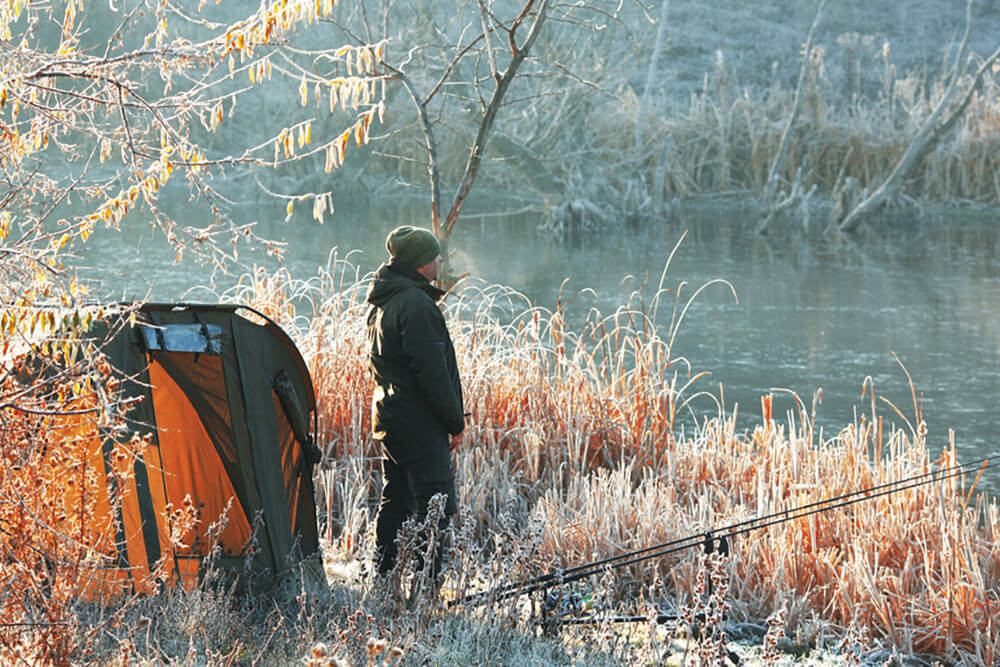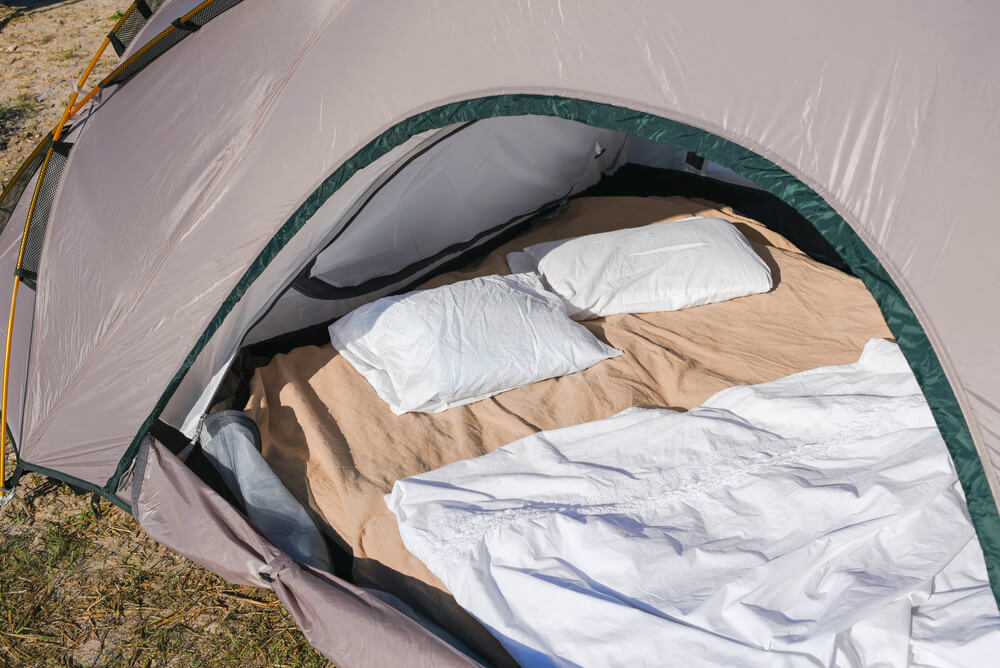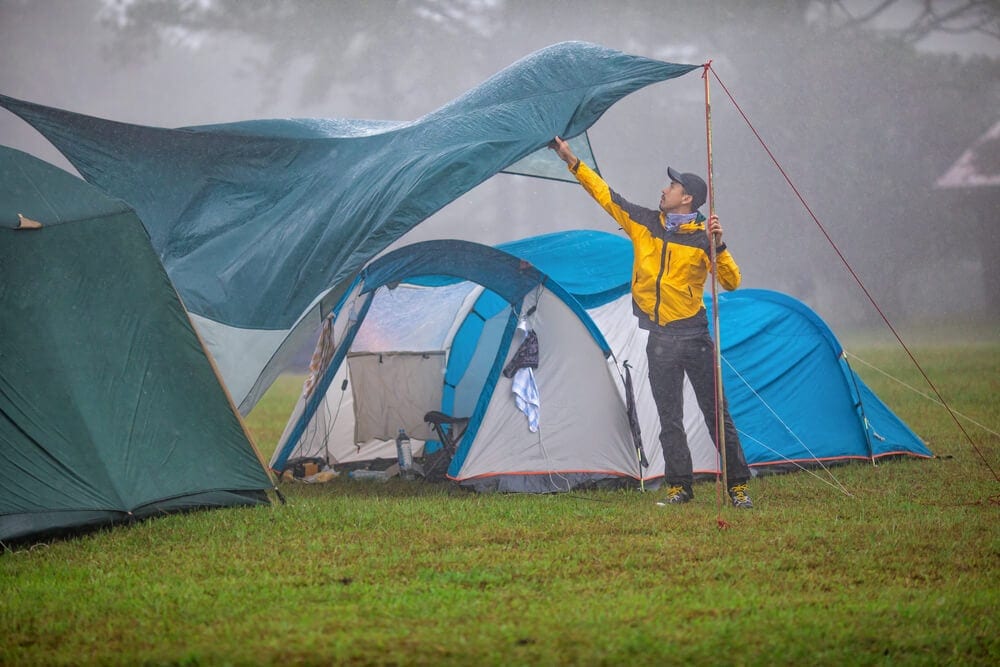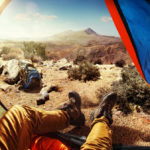Keep your bedding dry in a few steps
When you’re out and about in the great outdoors, getting away from the toxic city is like a never-ending rat race.
There’s a common ‘fly in the ointment that can take a lot of the fun out of it.
We’re talking about damp, of course, or, more specifically, damp bedding.
While a soggy night’s sleep can certainly lower morale, it’s easily avoided with some simple strategies.
This will be the subject of our article today.
All it takes is a few simple precautions, and once they become a habit, you’ll have a dry night’s sleep and feel all the better.
Let’s talk about how to keep bedding dry when camping to keep the water at bay while still sampling the best that nature offers!
Consider your Campsite Location
Selecting the right place to camp is vital if you want to keep mud, water, and other bits of detritus on the outside of your tent instead of the inside and keep your bedding dry.
It’s like a military endeavor in that you must ‘scout’ available locations in advance, know the terrain, and have a few backups handy.
First, the ‘scouting’ portion begins by finding out, typically by an online resource or a quick trip ahead, which sites are available and where.
You want to pick locations with a high elevation, as lower spots collect more water.
This brings us to the next scouting consideration – are there bodies of water close?
If so, good – you’ll need water, but you don’t want to be too close to it.
We recommend a distance of at least 200 feet to get the convenience and view without worrying too much if the weather turns for the worst.
Next, you need to consider the actual terrain.
You want a place with a little natural cover, but you should be mindful not to block anyone else’s view.
It’s all about ‘blending in,’ and that natural cover will help keep the water at bay.
Finally, pick three spots, not one – that way, you’ve got a backup if your spot gets grabbed before you can reserve it.

Think About Airflow
So, you’ve got a bit of natural cover, close to the water you need, and an excellent elevation to help avoid surprise dew-drenching.
It’s a good start, but the next important step to take is to ensure that your tent is put down in such a way as to minimize wind-carried moisture or raindrops blown right inside your tent.
This is relatively easy and an excellent habit of getting into.
In the United States, storms typically blow in from the south or the west… most commonly, the west.
You should ensure that your tent door faces the north or the east.
That helps keep cold or moist air from blowing into your tent and dampening your shelter.
It’s easy to do, and if you haven’t mastered gauging direction by sunrise and sunset, you can whip out your handy compass and quickly determine where to face your tent door.
It doesn’t sound like much, but if you’ve ever set your tent with the door facing to the south or the west and spent a few panicked seconds trying to close your tent as fast as possible, then you know exactly how useful this little trick can be.

Avoid bringing wet clothes and gear
With the perfect spot and elevation, plus your door in the optimal position, the next significant threat to your bedding is YOU.
Well, more specifically, it’s your clothes and gear.
Rain happens, as all campers know, and your best defense for keeping your bedding dry is a simply shedding protocol that all campers need.
Most tents will have a small section separating them from the ‘tent proper’.
Although if your tent doesn’t have one, you’ll usually still have a hook or hanger close to the door.
This is utilized by entering your tent and stopping in the separate or front section, closing the door, and dealing with gear.
This boils down to immediately removing wet clothing and gear and putting them in a separate section or hanging them in the front, as far away from your bedding as possible.
Planning ahead, you can put a set of dry clothes nearby in the morning, just in case of a storm, that you can quickly switch into.
Wet clothing and gear are the most common cause of soggy bedding.
But preparing in the way we’ve just described is a good habit that will help ensure warm, dry sleeping for many years to come.
Try it the next time you’re out, and you’ll see – a little preparation goes a long way towards a good night’s sleep.
Pack Air Mattresses
Air mattresses are a game changer.
Even the oldest ones have about a 10-inch thickness, separating you from the often-cold and sometimes wet tent floor.
But modern ones are considered ‘double high’ and even thicker than 10 inches.
Pack one or two for your next outing, and you’ll see what a good night’s sleep feels like. You can top it with your favorite sleeping bags or go whole-hog and prepare it like a bed at home.
Depending on the size, you could have a humble, comfy twin to help you get your ‘Z’s’.
Or if you have a larger tent, a glorious king-sized mattress will await the end of your day, and you can sleep like a sultan.
Once you deflate it, it folds up compactly to stow away until your next glorious adventure.
While some campers might feel this is ‘cheating,’ we recommend trying it.
There’s nothing quite like being in the middle of nature at its rawest and listening to the storm with someone special, dry, and comfortable in the thick of it.
It’s a minor concession to comfort that you definitely won’t regret.

Some last words on bone-dry bedding
Today we’ve talked about four simple tips that can make all the difference for keeping your bedding properly dry so you can get a good night’s sleep.
It all comes down to mindful terrain selection, directional storm statistics, sensible wet clothes and gear strategy, and an inflatable mattress to cement the whole equation.
Give these tips a try, and you’ll see for yourself – refreshing sleep will be assured, and you can focus your days on the critical thing – getting back to nature!







